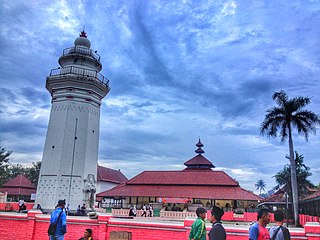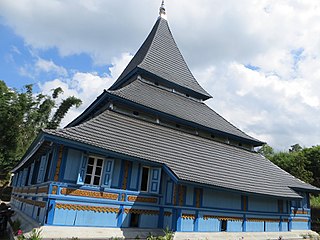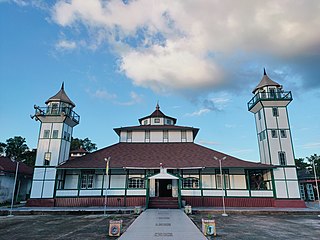The Kuntilanak, are also called Pontianak, is a mythological creature whose folklore has been spread through the Indonesian Archipelago. It is similar to the Langsuir in other Southeast Asia regions. In legend, the Kuntilanak takes the form of a pregnant woman who is unable to give birth to a child. It is often described as a vampiric, a vengeful female astral spirit. Another form of the Pontianak refers to the white lady of Southeast Asian folklore. This creature was also named after the province of Western Kalimantan region, whose the city of Pontianak was introduced, established by the Sultanate Syarif Abdurrahman Al-Qadrie during his voyage.

West Kalimantan is a province of Indonesia. It is one of five Indonesian provinces in Kalimantan, the Indonesian part of the island of Borneo. Its capital city is Pontianak. The province has an area of 147,307 km² with a recorded population of 4,395,983 at the 2010 Census. Ethnic groups include the Dayak, Malay, Chinese, Javanese, Bugis, and Madurese. The latest official estimate (2019) is 5,069,127. The borders of West Kalimantan roughly trace the mountain ranges surrounding the watershed of the Kapuas River, which drains most of the province. The province shares land borders with Central Kalimantan to the southeast, East Kalimantan to the east, and the Malaysian territory of Sarawak to the north.

Pontianak is the capital of the Indonesian province of West Kalimantan, founded by Syarif Abdurrahman Alkadrie as a capital of Sultanate of Kadriyah on 23 October 1771 / 14 Rajab 1185 AH.

Malay Indonesians are ethnic Malays living througout Indonesia. They are considered one of the indigenous peoples of the country. Indonesian, the national language of Indonesia, is a standardized form of Riau Malay. There were numerous Malay kingdoms in what is now Indonesia, mainly on the islands of Borneo and Sumatra. These included Srivijaya, the Melayu Kingdom, Dharmasraya, the Sultanate of Deli, the Sultanate of Siak Sri Indrapura, the Riau-Lingga Sultanate, the Sultanate of Bulungan, Pontianak Sultanate, and the Sultanate of Sambas.

The Pontianak Sultanate was an Islamic Malay state that existed on the western coast of the island of Borneo from the late 18th century until its disestablishment in 1950. The Sultanate was located at the mouth of the Kapuas river in what is today the Indonesian province of West Kalimantan, and the Sultan's residential palace was situated in what later grew to become the modern-day Indonesian city of Pontianak.

The Sultanate of Siak Sri Indrapura, often called Sultanate of Siak, was a kingdom that was located in the Siak Regency, Riau from 1722 to 1946 CE. It was founded by Raja Kechil, who from the Johor Kingdom, after he failed to seize the throne of the Sultanate of Johor. The polity expanded in the 18th century to encompass much of eastern Sumatra as it brought various communities under its control through warfare and control of trade between the interior of Sumatra and the Melaka Straits. The Dutch colonial state signed a series of treaties with Siak rulers in the 19th century, which reduced the area of state influence to the Siak River. For the remainder of the Dutch colonial era, it operated as an independent state with Dutch advisors. After Indonesia's Independence was proclaimed on 17 August 1945, the last sultan of Siak declared his kingdom to have joined the Republic of Indonesia.
The Pontianak incident consisted of two massacres which took place in Kalimantan during the Japanese occupation of the Dutch East Indies. One of them is also known as the Mandor Affair. The victims were from a wide variety of ethnic groups, and the killings devastated the Malay elite of Kalimantan, with all the Malay Sultans of Kalimantan executed by the Japanese.

Angke Mosque, officially known as Masjid Jami Angke or Masjid Al-Anwar, located at Tambora, Jakarta, Indonesia. It is one of the oldest mosques in Jakarta. Well-maintained and retaining its original form, the mosque has been called by the historian Denys Lombard as 'une des plus élégantes de la vieille villa'. The history of the mosque reflects the multiethnic and multilayered origin of colonial Jakarta.

The Great Mosque of Sumenep is an 18th-century mosque in Sumenep, Madura. Standing on the alun-alun of Sumenep, it is the largest mosque in Madura Island and a noted landmark of Madura.

The Great Mosque of Palembang, also known as Sultan Mahmud Badaruddin I Great Mosque after the former Sultan of Palembang, is the main mosque of Palembang, the capital of South Sumatra. The mosque is the largest in South Sumatra, and the third largest mosque in Sumatra after the Grand Mosque of West Sumatra and Great Mosque of Pekanbaru.

Great Mosque of Banten is a historic mosque in Old Banten, 10 km north of Serang, Indonesia. The 16th-century mosque was one of the few surviving remnants of what used to be the port city of Banten, the most prosperous trading center in the Indonesian archipelago after the fall of Demak Sultanate in mid-16th century.

Azizi Mosque is a mosque located in Tanjung Pura, North Sumatra, Indonesia. It was the royal mosque of the Sultanate of Langkat.

Jami Syekh Abdul Hamid Abulung Mosque, also known as Datu Abulung Mosque is an old mosque in South Kalimantan province, Indonesia, which is located in Sungai Batang village, West Martapura district, Martapura. The mosque was built by the king of Banjar, Sultan Tahmidullah II who ruled the area during 1761 to 1801, as a form of retribution for ordering the executions of Datu Abulung, a scholar who had been accused of heresy. The mosque is one of the cultural heritages in Martapura.

The Bingkudu Mosque is one of the oldest mosques in Indonesia, which was founded by the Padri in the wake of the Padri War in West Sumatra in 1823. This mosque with the typical Minangkabau style architecture is located in Jorong Bingkudu, Nagari Canduang Koto Laweh, Canduang District, Agam Regency, West Sumatra. When it was first built, the building of the mosque was made of wood, on its floor, pole, and its wall.

Tuo Koto Nan Ampek Mosque, also known as Gadang Balai Nan Duo Mosque is one of the oldest mosques in Indonesia located in Koto Nan Ampek Nagari, now administratively included into the area of Balai Nan Duo village, West Payakumbuh District, city of Payakumbuh, West Sumatera. The Minangkabau architecture is thought to have been built in 1840, which was originally covered with fiber roofs before being replaced with zinc. Currently other than being used for Muslim worship activities, this single-level mosque is also used by the surrounding community as a means of religious education.

Jami Mosque of Sintang also known as Sultan Nata Mosque is a mosque located in Sintang, West Kalimantan, Indonesia. The mosque is located within the complex of Istana al-Mukarrammah, the main palace of the Sultanate of Sintang, a kingdom in Sintang which existed since the 13th-century.

Jami Mosque of Air Tiris is a historical congregational mosque in Riau, Indonesia. The mosque is famously known for being built without nails and considered a cultural heritage of the Riau Province. The mosque is located in Air Tiris Village, Kampar Regency, 50 km from Pekanbaru, the capital of Riau Province. The mosque is officially designated as an Object of Cultural Heritage in 2004 based on the decree no. KM.13/PW.007/MKP/2004 adopted by the Minister of Culture and Tourism, I Gede Ardhika.























